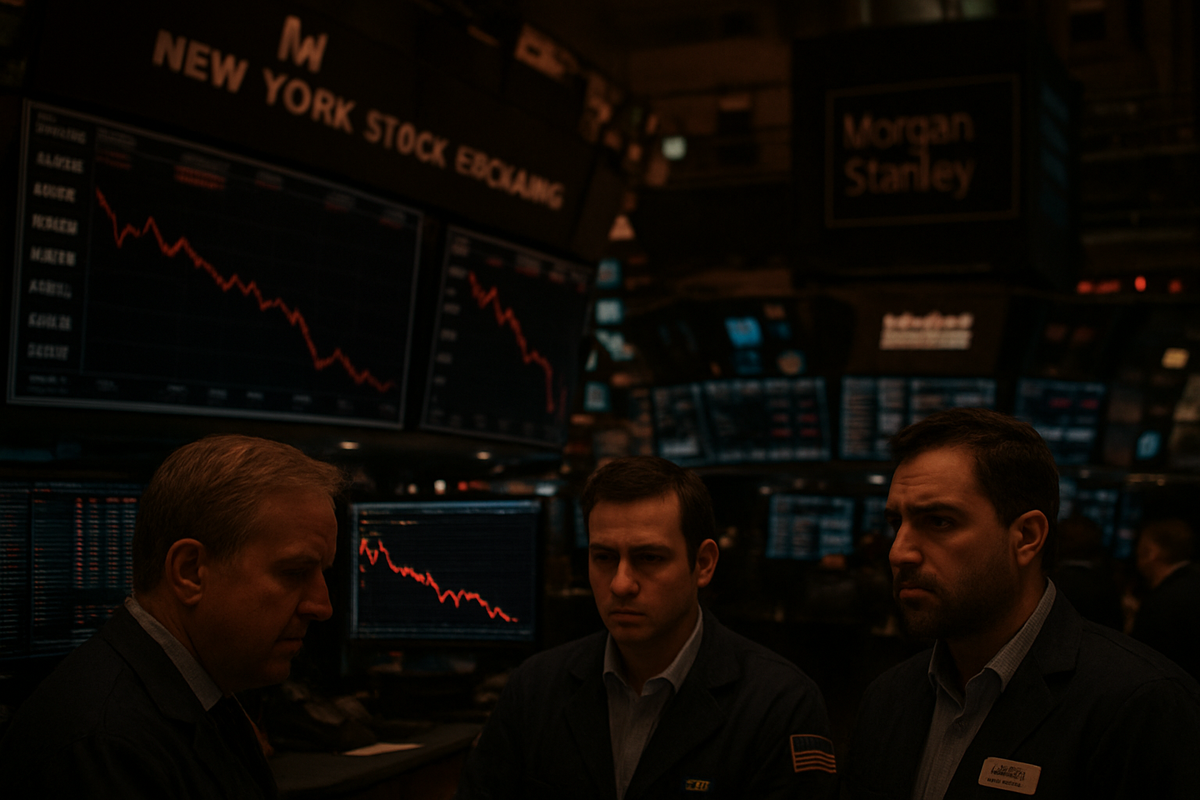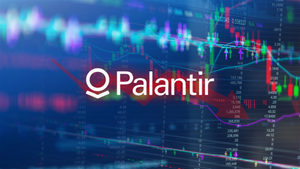
New York, NY – November 4, 2025 – Major Wall Street institutions, Goldman Sachs (NYSE: GS) and Morgan Stanley (NYSE: MS), have issued fresh and urgent warnings regarding a potential significant stock market correction. Speaking at the Global Financial Leaders' Investment Summit in Hong Kong today, their top executives articulated growing concerns that investor exuberance has propelled global equity valuations to unsustainable heights, setting the stage for a notable pullback.
These pronouncements suggest that investors should brace for a period of heightened volatility and potential capital erosion. The warnings, coming from two of the financial world's most influential voices, signal a cautious outlook for equity markets as a confluence of factors, from stretched valuations to policy uncertainties, threatens to disrupt the current bullish sentiment.
Wall Street Giants Sound Alarm: A Looming Market Correction?
The gravity of these warnings underscores a significant shift in sentiment among some of the market's most seasoned observers. Morgan Stanley (NYSE: MS) CEO Ted Pick suggested that global equity markets could experience a "healthy" drawdown of 10% to 15%, emphasizing that such pullbacks are a normal and even beneficial part of market cycles, provided they are not triggered by a sudden "macro cliff effect." Concurrently, Goldman Sachs (NYSE: GS) CEO David Solomon cautioned that a more substantial 10% to 20% pullback in equity markets is likely within the next 12 to 24 months. Solomon advised long-term investors to remain invested and review their portfolios rather than attempting to time the market, viewing such reversals as inherent to sustained bull markets.
These latest alerts echo sentiments expressed earlier in the year. In January 2025, Goldman Sachs analysts had already raised alarms about an imminent correction in the US stock market, with some projections indicating a possible drop of up to 30% over the course of the year and the probability of an equity drawdown rising to around 30%. Morgan Stanley's outlook for 2025, published in April and February, generally anticipated more muted, single-digit gains and increased volatility, signaling a "pause" year for the S&P 500 but stopping short of predicting an outright bear market at that time. Today's statements, however, solidify a more immediate and tangible threat of a significant correction.
The warnings cite a multifaceted array of reasons contributing to the increased risk. A primary concern is the "sky-high valuations" and pervasive investor optimism that have driven the S&P 500 to repeated record highs, drawing comparisons to the dot-com bubble era. Despite robust corporate earnings, the current S&P 500 valuation of 23 times forward earnings significantly exceeds its five-year average of 20x, indicating a market "priced for perfection," as Goldman Sachs previously noted. Furthermore, persistent inflation and elevated interest rates, which markets have largely overlooked, coupled with potential further rises in bond yields, present a vulnerability.
Adding to the complexity is significant policy uncertainty, exacerbated by shifting trade dynamics and an ongoing federal government shutdown, now in its fifth week. Morgan Stanley had previously highlighted extreme uncertainty around tariffs and other policy shifts from Washington, D.C., which could pressure "risk premiums." The market's heavy concentration, particularly in the US technology sector and the "Magnificent 7" mega-cap tech stocks, also makes it highly susceptible to growth disappointments, with Morgan Stanley noting earlier in 2025 that these dominant players were already showing signs of losing their luster due to slowing growth. Lastly, the fervent enthusiasm and speculative investment in Artificial Intelligence (AI)-linked stocks have drawn comparisons to the dot-com bubble, raising fears of an impending speculative bust.
Companies on the Brink: Winners and Losers in a Market Pullback
A significant market correction, as warned by Goldman Sachs (NYSE: GS) and Morgan Stanley (NYSE: MS), will inevitably create a divergence in corporate performance, separating the vulnerable from the resilient. Sectors with elevated valuations and high growth expectations, particularly those susceptible to discretionary spending shifts or reliant on future growth narratives, are expected to bear the brunt of a downturn. The technology sector, especially high-growth and speculative tech companies, stands out as particularly vulnerable. Goldman Sachs analysts have specifically highlighted the risk of over-investment by dominant tech companies in areas like Artificial Intelligence (AI) and data centers, where returns may not justify the capital deployed. The "Magnificent Seven" mega-cap tech stocks, which have disproportionately driven recent market rallies, face intense scrutiny over their valuations and substantial AI-related expenditures, making them prime candidates for significant pullbacks.
Beyond technology, consumer discretionary companies are also highly susceptible. Reduced consumer confidence and spending during a correction could lead to significant declines for businesses involved in non-essential goods and services, such as automobile manufacturers, airlines, hotels, and luxury brands. The financial sector could also face headwinds, with increased economic uncertainty potentially leading to reduced borrowing, higher loan loss provisions for banks, and decreased transaction volumes for investment firms. Similarly, cyclical sectors like industrials and energy, which are sensitive to business investment and commodity prices, would likely suffer from reduced demand and manufacturing activity during an economic slowdown. Real estate, too, could see negative impacts from rising interest rates and declining property transactions.
Conversely, defensive sectors are poised to offer greater resilience and may even attract increased investment as a flight to safety occurs. Consumer staples, which provide essential goods like food, beverages, and household products, typically maintain stable demand regardless of economic conditions. Companies such as PepsiCo (NASDAQ: PEP), Procter & Gamble (NYSE: PG), and discount retailers like Walmart (NYSE: WMT) or Costco (NASDAQ: COST) are likely to see stable revenue streams. Similarly, utilities, providing essential services like electricity and water, offer consistent performance due to regulated revenues and inelastic demand. The healthcare sector, encompassing pharmaceutical companies like Johnson & Johnson (NYSE: JNJ) and biotechnology firms, also tends to be resilient as demand for medical services remains constant.
Furthermore, the defense sector, largely insulated by consistent government military budgets and long-term contracts, often provides stable returns during periods of economic uncertainty. Companies with strong fundamentals, robust balance sheets, consistent profitability, and reasonable valuations across any sector are also better positioned to weather a downturn. As Morgan Stanley emphasizes a return to fundamentals, "quality" investments that can demonstrate consistent earnings and manage debt effectively will likely attract capital, potentially even enabling them to acquire distressed assets from weaker competitors in a challenging market.
Broader Implications: Navigating a Shifting Economic Landscape
The warnings from Goldman Sachs (NYSE: GS) and Morgan Stanley (NYSE: MS) on November 4, 2025, extend beyond immediate market reactions, signaling profound shifts within the broader financial landscape. These pronouncements fit into a narrative of increasing risk aversion and potential deleveraging across the industry, as investors reconsider their exposure to high-growth, high-valuation assets. The current environment is characterized by several intertwined trends: sky-high valuations, persistent inflation, elevated interest rates, and significant policy uncertainty, including an ongoing federal government shutdown and the specter of shifting trade dynamics under a new administration. The unusual concentration of market returns in a few mega-cap technology stocks, particularly the "Magnificent 7," further amplifies systemic risk, making the market vulnerable to any weakness in these key players.
The ripple effects of a potential correction could be extensive, impacting not only direct competitors like JPMorgan Chase (NYSE: JPM) and Bank of America (NYSE: BAC) but also asset managers, hedge funds, and corporate borrowers globally. Investment banks and brokerages might initially see a surge in trading volumes due to selling pressure, but sustained downturns could lead to reduced transaction revenues and a slowdown in lucrative IPO and M&A activity. Asset managers could face significant outflows, while pension funds and endowments would be compelled to reassess asset allocations to protect beneficiaries. Globally, the International Monetary Fund (IMF) has already expressed concerns about growing global exposure to U.S. equities, warning that a sharp correction could have severe international consequences, particularly for emerging markets sensitive to global risk sentiment.
From a regulatory and policy standpoint, a market correction could trigger responses from central banks and governments. The Federal Reserve, which has recently scaled back expectations for 2025 rate cuts, might be pressured to consider further monetary policy adjustments, such as interest rate cuts or liquidity provisions, to stabilize markets and support economic activity. Governments might also contemplate fiscal stimulus measures to counteract an economic slowdown. Periods of market stress historically lead to increased regulatory scrutiny, with authorities investigating market conduct and systemic risks to prevent excessive speculation, drawing lessons from past crises.
Historically, the current market dynamics share unsettling parallels with the dot-com bubble of 2000, as noted by both Goldman Sachs and the IMF, particularly concerning the speculative fervor around AI-linked stocks. Warnings about overvalued tech assets preceded the bursting of that bubble, leading to a prolonged bear market. While the triggers differ, the underlying mechanisms—unjustified valuations, speculative investment, and eventual re-pricing—remain consistent. Other precedents, like the 2008 financial crisis or the 2018 market correction driven by interest rate concerns and trade tensions, underscore how quickly sentiment can shift and the profound impact of macroeconomic factors and policy uncertainty on market stability.
The Road Ahead: Scenarios and Strategic Responses
As Wall Street grapples with the prospect of a market correction, investors and corporations must consider a range of short-term and long-term possibilities and prepare for strategic pivots. In the immediate future, increased market volatility is a near certainty. Dow Futures, S&P 500 futures, and Nasdaq 100 futures have already shown weakness in the wake of these warnings, with technology shares, particularly the "Magnificent Seven" mega-caps and AI bellwethers like Palantir (NYSE: PLTR) and Nvidia (NASDAQ: NVDA), experiencing premarket declines due to valuation concerns. This suggests a swift re-evaluation of high-growth, high-valuation segments.
Looking further ahead, the consensus from both Goldman Sachs (NYSE: GS) and Morgan Stanley (NYSE: MS) is that a 10-20% drawdown, while impactful, represents a "healthy" normalization within a long-term bull market, rather than a catastrophic "macro cliff effect." By 2026, market performance is expected to become more strongly tied to fundamental corporate earnings, leading to greater divergence where robust companies continue to outperform. However, the risk of an "AI bubble" bursting, reminiscent of the dot-com era, remains a bearish scenario if AI investments fail to yield tangible returns, potentially triggering a more severe, 30% or greater correction. Monetary policy will also play a crucial role; while the Federal Reserve scaled back 2025 rate cut expectations in September, continued cuts, albeit slower, could be positive, though concerns about U.S. government debt persist.
For investors, the key adaptation is not to attempt to time the market but to proactively review and diversify portfolios. Maintaining sufficient cash reserves is paramount to cover expenses and avoid forced selling during downturns. A "buy the dips" mentality, for those with available capital, could present opportunities to acquire quality assets at lower prices. Strategic pivots should include a focus on high-quality stocks with strong fundamentals and a wide margin of safety, adopting a "barbell strategy" that balances growth-oriented equities with defensive assets like gold (COMEX: GC=F) and cash. Alternative assets, such as private credit and secondaries, also offer compelling risk-adjusted returns.
Market challenges include persistent overvaluation in tech and AI, narrow market breadth, and historically high margin debt levels, all of which could exacerbate a downturn. However, opportunities exist. Both Goldman Sachs and Morgan Stanley highlight significant growth prospects in Asian markets, including Hong Kong (HKEX: 388), China (SSE: 000001), Japan (JPX: 8035), and India (NSE: NIFTY). These markets offer unique economic narratives, easing trade tensions, and strong investor interest in sectors like AI, electric vehicles, and biotechnology. Volatility, while challenging, also creates strategic buying opportunities for long-term investors in undervalued assets across technology, consumer discretionary, healthcare, industrials, and small-cap companies.
Conclusion: Prudence in a Precarious Market
The synchronized warnings from Wall Street titans Goldman Sachs (NYSE: GS) and Morgan Stanley (NYSE: MS) on November 4, 2025, serve as a potent reminder that even in seemingly robust markets, prudence remains paramount. The core message is clear: a significant stock market correction of 10% to 20% is not just a possibility but a likely event within the next one to two years, driven by a confluence of stretched valuations, persistent inflation, elevated interest rates, and pervasive policy uncertainties. These are not calls for panic, but rather a strategic re-evaluation of risk and reward in an "environment that has been priced for perfection."
Moving forward, the market is poised for increased volatility and a more discerning approach to asset valuation. The era of broad-based gains, particularly fueled by a concentrated group of mega-cap tech stocks, may be giving way to a period where fundamental corporate earnings and sound balance sheets dictate performance. While a "healthy" correction can cleanse market excesses and create new entry points, the risk of a more severe downturn, especially if the speculative fervor around AI fails to deliver tangible returns, cannot be ignored. The interconnectedness of global markets also means that a U.S. correction could have far-reaching international consequences.
The lasting impact of these warnings will likely be a heightened sense of vigilance among investors and a renewed focus on diversification and risk management. It underscores the importance of a long-term investment horizon, avoiding the temptation to time the market, and instead focusing on portfolio resilience. Investors should closely monitor key economic indicators, including inflation data, interest rate decisions from central banks like the Federal Reserve, geopolitical developments, corporate earnings reports, and any shifts in government policy, particularly concerning trade and fiscal matters. The coming months will test market resolve and investor discipline, making informed decision-making more critical than ever.
This content is intended for informational purposes only and is not financial advice





